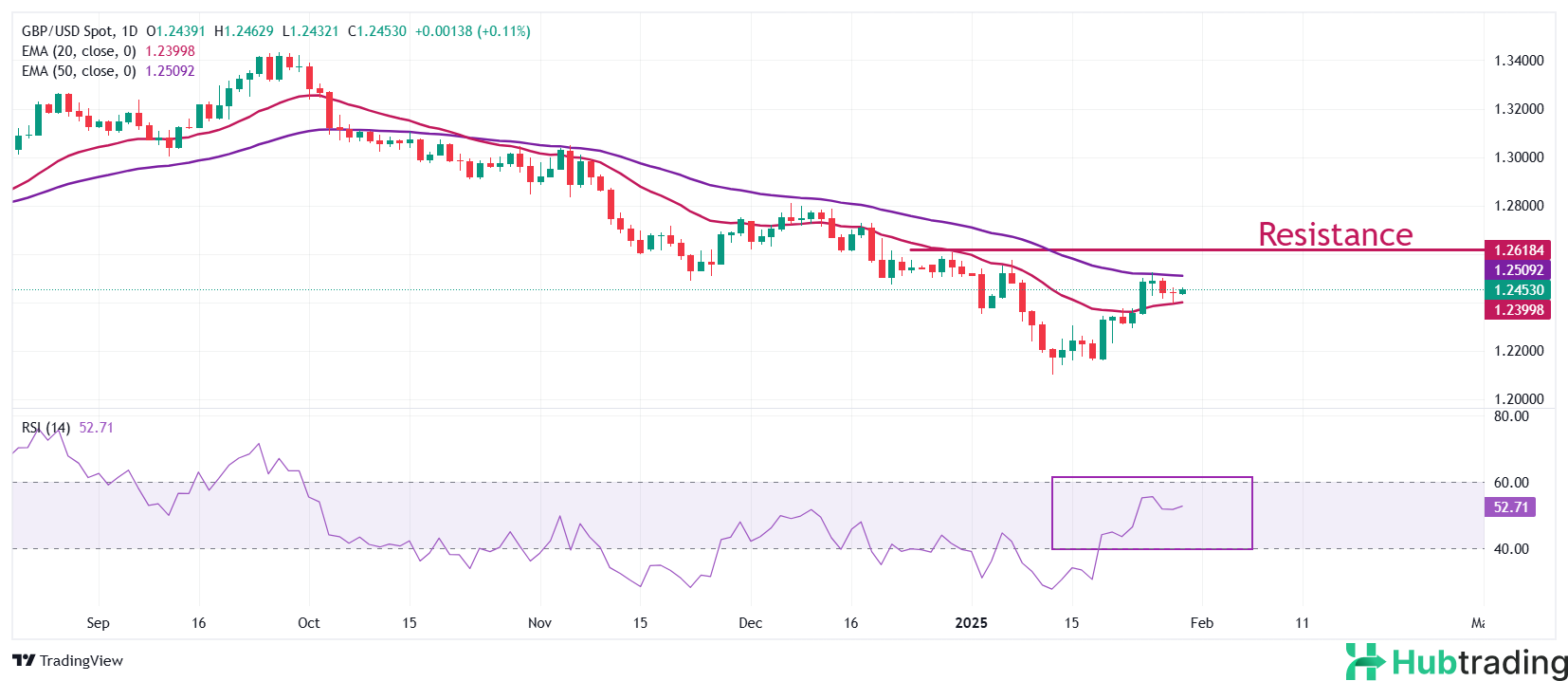- The Pound Sterling strengthens against the US Dollar following weaker-than-expected US Q4 GDP data.
- US President Trump pledges to combat inflation through liberalization and increased oil production.
- The Bank of England is anticipated to cut interest rates by 25 bps next week.
The Pound Sterling (GBP) climbed to nearly 1.2460 against the US Dollar (USD) during North American trading on Thursday, as the Greenback weakened following disappointing US Q4 GDP data. The US economy expanded by 2.3% year-over-year (YoY), falling short of the expected 2.6% and slowing from the 3.1% growth recorded in Q3 2024.
Meanwhile, Initial Jobless Claims for the week ending January 24 came in lower than anticipated, with 207K new claims, beating estimates of 220K and down from the prior release of 223K. The decline in jobless claims suggests a resilient labor market, potentially supporting the Federal Reserve's (Fed) stance of keeping interest rates steady for longer.
On Wednesday, as widely expected, the Fed left interest rates unchanged in the 4.25%-4.50% range and maintained a cautious outlook. Fed Chair Jerome Powell emphasized that further policy adjustments would only be considered with "real progress on inflation or some weakness in the labor market."
The Fed's wait-and-see approach contrasts with President Donald Trump's push for immediate rate cuts. Speaking at the World Economic Forum (WEF) in Davos, Trump criticized the central bank's stance, later stating on Truth Social that the Fed has done a "terrible job on Bank Regulation." He vowed to "lower inflation himself" through initiatives such as boosting energy production, strengthening American manufacturing, and reducing regulation.
Looking ahead, investors will closely monitor the Personal Consumption Expenditure (PCE) Price Index data for December, set to be released on Friday. The Fed's preferred inflation measure, core PCE inflation, is projected to rise by 0.2% month-over-month, up from 0.1% in November, while the annual figure is expected to hold steady at 2.8%.
Daily Market Movers: Pound Sterling Strengthens as UK's Reeves Pushes for Regulatory Reforms
- The Pound Sterling (GBP) trades firmly against its major counterparts, except for the Japanese Yen (JPY), during Thursday's North American session. The British currency gains momentum as UK Chancellor of the Exchequer Rachel Reeves outlines a comprehensive strategy to accelerate economic growth. In a speech delivered in Oxfordshire, Reeves introduced several initiatives, including a "growth corridor" between Oxford and Cambridge, aimed at enhancing the UK's economic prospects.
- Reeves reaffirmed Prime Minister Keir Starmer's optimistic economic outlook, declaring that the UK economy is on the verge of a "turnaround." She pledged to eliminate "stifling and unpredictable" regulations to improve productivity. Additionally, she expressed her intent to strengthen economic ties with the United States (US) under President Donald Trump's leadership and looks forward to working with Treasury Secretary Scott Bessent to foster bilateral trade.
- Despite Reeves' ambitious agenda, the immediate economic impact is expected to be limited. The UK continues to grapple with structural challenges, which are likely to push the Bank of England (BoE) toward resuming its rate-cut cycle as early as next week.
- The BoE is set to meet in early February and is widely anticipated to lower interest rates by 25 basis points (bps) to 4.5%. If confirmed, this would mark the third rate cut since August, when borrowing costs peaked at 5.25%.
Technical Analysis: Pound Sterling Struggles Near 50-Day EMA

The Pound Sterling (GBP) remains under pressure against the US Dollar (USD), fluctuating around 1.2450 on Thursday. Despite recent consolidation, the GBP/USD pair maintains a firm near-term outlook, holding above the 20-day Exponential Moving Average (EMA) at 1.2400. However, the 50-day EMA at 1.2510 continues to act as a strong resistance level, limiting further upside movement.
The 14-day Relative Strength Index (RSI) has climbed above 50.00, recovering from the 20.00-40.00 range, indicating that bearish momentum has subsided-at least for now.
On the downside, key support levels include the January 13 low of 1.2100 and the October 2023 low of 1.2040. Conversely, if Sterling bulls regain control, the December 30 high of 1.2607 will serve as the next significant resistance level.





